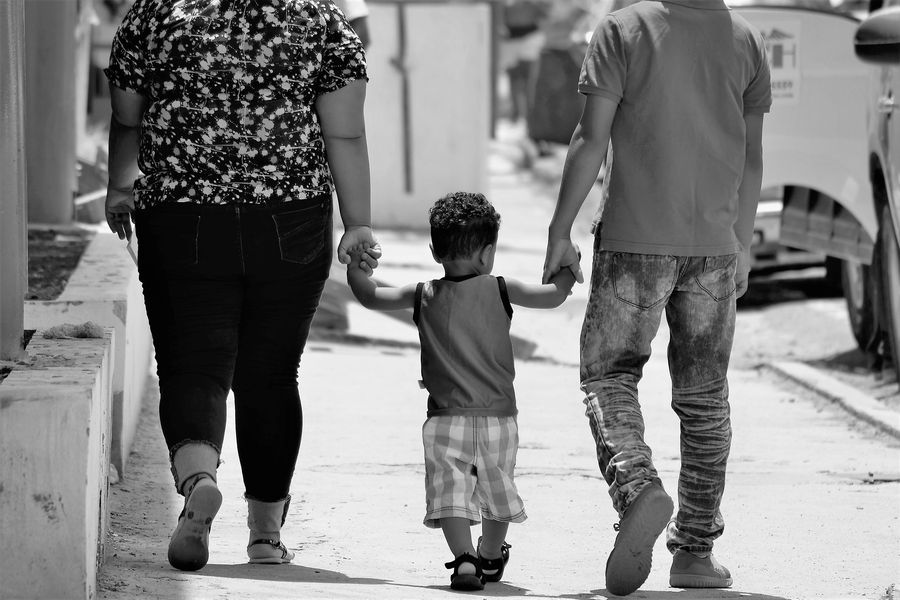Sleeping with Parents vs. Separate Sleeping: What’s Best for Your Child?
As a parent, one of the most pressing questions you may face is whether to let your child sleep with you in the same bed or in a separate room. Historically, it was acceptable for children to share a bed with their parents, but as society changes, so do our parenting practices.
In this article, we’ll take a closer look at the benefits and drawbacks of co-sleeping and separate sleeping, and provide tips on how to help your child sleep alone.
Benefits of Co-Sleeping with Your Child
One of the main advantages of co-sleeping is that it can be easier for new mothers who may be nursing throughout the night. If your child is in the same bed, you don’t have to get up and walk to another room to tend to your child’s needs.
This can lead to a more relaxed and stress-free atmosphere for both the mother and child. Another perk is the sense of security it provides.
Children can feel safer and more secure when they know their parents are nearby. This can lead to a better night’s sleep for both the child and the parent.
Drawbacks of Children Sleeping with Parents
While there are benefits to co-sleeping, there are also some drawbacks. One of the main problems with sharing a bed with your child is that it can lead to a dependency.
Children who sleep in the same bed with their parents tend to grow anxious when they are not there, and may struggle to sleep if they are left alone. Another issue is that it can affect intimacy between the couple.
If you’re always sleeping with your child, it can lead to a lack of privacy and may make it challenging to maintain a romantic relationship with your partner. Lastly, children who co-sleep can become grumpy and demanding if they don’t get their way.
They may be more likely to wake up in the middle of the night and demand attention from their parents, making it difficult for both the child and the parent to get a good night’s sleep.
Teaching Children to Sleep Alone
If you’ve decided to have your child sleep in a separate room, there are some things you can do to help them get used to the idea. First, explain to them why they need to sleep alone.
Let them know that it’s part of growing up and that it’s okay to be in their own room. You can also take steps to make their room feel less scary.
Invest in a nightlight or read a bedtime story that ends with a happy ending. Be there to tackle their fears when they arise.
Help them take their loneliness in stride and encourage them to be self-reliant by not coming to their room every time they cry out. Additionally, be supportive and consistent with your child’s new sleeping arrangement, and continue to offer them reassurance and love.
It may take some time, but with patience and perseverance, your child can learn to sleep alone successfully.
The Importance of a Secure Home
Another essential aspect of raising a child is providing them with a secure home environment. A safe and stable home helps children develop emotional stability, which is essential in their overall well-being.
Parental Protection and Children’s Response
As parents, our love and care for our children can give them a sense of security that is difficult to find anywhere else. When children feel protected and valued by their parents, it cultivates a more confident and outgoing personality.
It also fosters a nurturing environment, which is a critical aspect of their overall mental and emotional development.
The Need for a Secure Home
Creating an environment that is safe and secure is not only in the best interest of the child; it also benefits parents. Parents who establish routine schedules and rules that their children must follow will have a smoother household.
They will be able to understand their children’s needs and be able to attend to them with peace of mind, knowing that their child is safe and secure.
Conclusion
In conclusion, both co-sleeping and separate sleeping have their benefits and drawbacks. While co-sleeping can provide a sense of security, it can also create dependency issues.
Similarly, keeping a child in a separate room can help parents maintain intimacy, but it may lead to a feeling of being alone for the child. Ultimately, it is up to the parent to decide what sleeping arrangement works best for their family.
Creating a secure home environment is also crucial in raising a well-rounded and happy child. A safe and stable home fosters emotional stability, which is essential for a child’s overall well-being.
With the help of these tips, parents can create a home that is both secure and nurturing, providing their children with the love and care they need to thrive.
Cultural Views on Co-Sleeping
Co-sleeping has been a historical tradition in many cultures, where it is deemed as a natural and appropriate way to ensure the safety of infants while they sleep. From sharing a room with the infant to sharing a bed, co-sleeping is still deemed as culturally acceptable in many societies around the world.
In Japan, co-sleeping has been a traditional practice for centuries, known as the futon, where the family sleeps together on a mattress on the floor. In African cultures, co-sleeping is viewed as a way to foster a close bond between the parent and child, as well as a practical way to keep the infant warm in cold climates.
In many places in Central and South America, it is common for families to sleep in the same bed. Co-sleeping is also seen as a way to help reduce the risk of sudden infant death syndrome (SIDS) in many cultures.
Importance of Cultural Awareness
It is essential to understand cultural differences and traditions when it comes to co-sleeping. Cultural beliefs and practices provide insight into why families co-sleep, creating a better understanding of the unique circumstances and needs of different families.
It means acknowledging that customs and beliefs are vital to a particular culture and should be respected. When we understand cultural differences, it can help us to provide safe and appropriate healthcare advice to families with different cultural backgrounds.
It is essential to provide culturally sensitive advice, which will help parents and infants to bed share safely and avoid potential safety risks.
Breastfeeding and Co-Sleeping
Co-sleeping can also affect breastfeeding. For many new mothers, co-sleeping can make breastfeeding easier since nighttime feeding means fewer disruptions to the mother’s sleep.
The mother and infant can be close, and the mom can respond to the infant’s needs immediately, which helps to strengthen the bond between mother and child.
The Benefits of Co-Sleeping for Breastfeeding
Breastfeeding is made easier when the infant is sleeping close to the mother. Co-sleeping allows for easier nighttime feedings, especially for breastfeeding mothers.
It means that mothers won’t have to get up to retrieve their baby from its crib or another room, promoting a more relaxed and stress-free atmosphere for both the mother and baby. Additionally, co-sleeping can help regulate the infant’s breathing, body temperature, and heart rate, which can lead to better outcomes for the baby.
When the mother and infant are close together, the infant can regulate its breathing based on its mother’s breathing patterns, which can improve the infant’s overall health.
The Risks of Co-Sleeping for Breastfeeding
Amid the benefits of co-sleeping, there are also some risks of co-sleeping while breastfeeding. The primary risk is that the infant can be smothered while sleeping with their mother, leading to suffocation.
This poses a significant danger, particularly for young infants who cannot shift or move themselves out of harm’s way. With these risks in mind, it is essential to be mindful of the baby’s position and surroundings while co-sleeping.
The American Academy of Pediatrics discourages co-sleeping with an infant for at least the first year of life, as the risk of accidental injury or death from bed-sharing is significantly higher during the first year of life. In conclusion, while there are benefits to co-sleeping, there are also potential risks.
When it comes to breastfeeding, co-sleeping can make things easier for the mother and promote a closer bond between the mother and child. But it’s important to be vigilant and protect the infant’s safety as well.
Finally, when it comes to cultural views on co-sleeping, it is essential to respect and understand cultural differences and recognize those beliefs and practices that are unique to each culture.
The Psychological Effects of Co-Sleeping
Co-sleeping has long been a topic of debate among parents, and its psychological effects on children are one of the main areas of discussion. While co-sleeping can have some benefits, it can also create dependency issues for the child, leading to emotional attachment.
Co-Sleeping and Dependency
When children sleep in the same bed with their parents, they may become overly dependent on the parent. They may become reluctant to sleep alone, and their anxiety may exacerbate when their parents are not beside them.
They may also find it challenging to cope with stress or anxiety when they are not in their secure home environment. This dependence may extend beyond bedtime, leading to a child who is consistently reliant on their parent for comfort and support, making it challenging to foster their emotional independence.
The Negative Effects of Co-Sleeping
Co-sleeping has been found to have some negative effects on children depending on their temperament and level of independence. Children who co-sleep can become grumpy and demanding if they don’t get their way.
They may struggle to cope with feelings of anxiety, leading to a higher probability of behavioral issues. In contrast to their peers, children who co-sleep may feel entitled to seek attention from their parents whenever they want, which can lead to poorer social skills and increased anxiety when separated from their parents.
Children who consistently co-sleep with their parents can find it challenging to cope when things don’t go their way.
Teaching Children Independence
It’s essential to teach children self-reliance and independence to prevent the negative psychological effects of co-sleeping. Parents can help by establishing routines and boundaries to foster a sense of emotional independence and security for their child.
It’s important to ensure children learn coping skills for when they are feeling anxious or have difficulty sleeping alone in their own bed. Parents should keep the environment upbeat and positive and respond with reassurance to the child’s needs.
Acknowledge the child’s feelings and understand that they need to feel secure in their environment. Above all, parents should be patient and consistent with their efforts to teach their child self-reliance.
They should acknowledge that it may take time and require a gradual transition in an effort to avoid frustration and anxiety. Acknowledging how challenging it can be for children to learn new routines is important and parents should be mindful of how their child is coping.
Conclusion
While co-sleeping can have some psychological benefits, such as promoting a sense of security and closeness with the child, it can also create dependency issues that could cause negative psychological effects for the child. Children who co-sleep may feel anxious and grumpy and may struggle with emotional independence.
Parents can teach their children independence by establishing routines, keeping a positive environment, and responding with reassurance to the child’s needs. With patience and consistency, parents can help their child become more self-reliant and mitigate the potential negative psychological effects of co-sleeping.
In conclusion, co-sleeping is a personal decision that depends on the family dynamics and cultural beliefs. While there are benefits to co-sleeping, such as promoting closeness and a sense of security, there are also potential drawbacks, such as dependency issues and negative psychological effects for the child.
However, understanding cultural differences and traditions is crucial, and teaching children self-reliance and independence can mitigate the potential negative psychological effects of co-sleeping. By weighing the benefits and drawbacks and making an informed decision that works best for the family, parents can create a safe and nurturing environment that fosters emotional stability and well-being for both parents and children.



